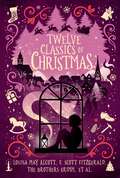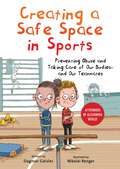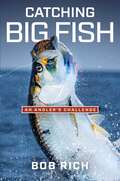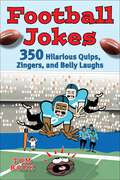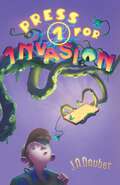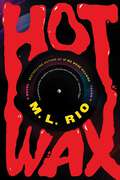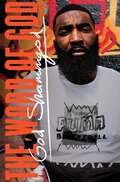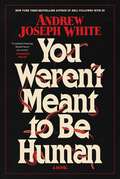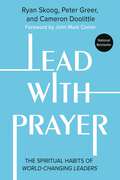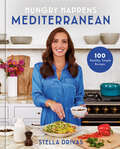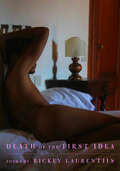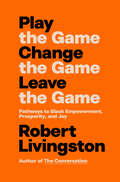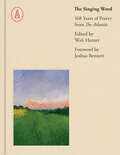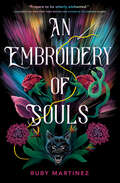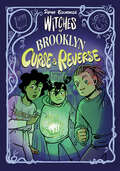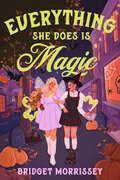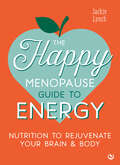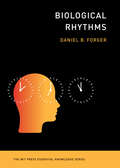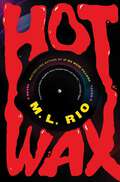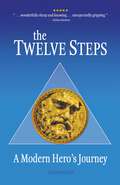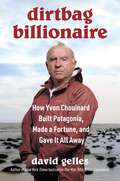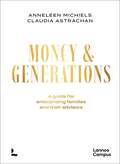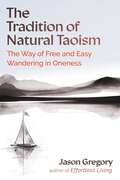- Table View
- List View
Twelve Classics of Christmas (The Essential Christmas Classics Collection)
by VariousCount down to the holidays with this collection of twelve of the most famous Christmas stories in this cozy anthology.Usher in the holidays with this collection of twelve classic short stories and poems from renowned authors such as Louisa May Alcott, F. Scott Fitzgerald, the Brothers Grimm, and Charles Dickens. From &“A Visit from St. Nicholas&” to &“The Gift of the Magi,&” many of these classics full of hope, humor, and holiday magic have been staples of the season for generations. With each one brief enough to be read in one sitting, these tales from Christmases past are the perfect way to welcome the holiday. This cozy collection includes: &“A Kidnapped Santa Claus&” by L. Frank Baum &“The Elves and the Shoemaker&” by Jacob and Wilhelm Grimm &“The Gift of the Magi&” by O. Henry &“Tilly&’s Christmas&” by Louisa May Alcott &“Squeaky and the Scare Box&” by Georgene Faulkner &“Papa Panov&’s Christmas Special&” by Ruben Saillens, translated by Leo Tolstoy &“The Christmas Masquerade&” by Mary E. Wilkins Freeman &“A Christmas Inspiration&” by L. M. Montgomery &“A Luckless Santa Claus&” by F. Scott Fitzgerald &“The Legend of the Babouscka&” by Anonymous &“The Story of the Goblins Who Stole a Sexton&” by Charles Dickens &“A Visit from St. Nicholas&” by Clement C. Moore
Creating a Safe Space in Sports: Preventing Abuse and Taking Care of Our Bodies—and Our Teammates (Emotional Education for Elementary Schoolers)
by Dagmar GeislerFrom award-winning author Dagmar Geisler, in collaboration with illustrator Nikolai Renger, a brand-new series for elementary school students about social-emotional learning and physical and mental health. Nora loves gymnastics, but she&’s not so sure how she feels about her new coach, Sven. There&’s something strange about him. She doesn&’t like when he tries to help her. She wants to talk to her teammates or someone else about it, but she&’s afraid no one will like her anymore if she does. Physical and sexual abuse of children largely takes place in their immediate environments—sports clubs and gyms included. This book sensitively provides a child-friendly explanation of what abuse may look like in this environment, as well as instructions for children to help them respond to this behavior if it happens to them. In addition to exploring sexual abuse and violence so that children may recognize the signs if it happens to them or even another teammate, this book also tackles other hard-hitting and difficult topics when it comes to kids in sports, including: Pushing their bodies beyond their limits Playing through injuries instead of taking much-needed breaks Committing to sports and teams to impress parents and coaches when their heart isn&’t in it anymore As professional athlete Alexandra Ndolo writes in the afterword, "This book encourages children to pay attention to their feelings and to verbalize them, even in the context of sports. It sensitizes parents and caregivers to pay attention to the warning signs and to take statements seriously and to intervene if they suspect something."Creating a Safe Space in Sports is a strong conversation-starter for adults and children and is also a practical guide.
Catching Big Fish: An Angler's Challenge
by Bob RichA high-stakes fishing memoir, Catching Big Fish follows Bob Rich&’s quest to become the first angler to conquer the legendary Met Tournament Hall of Fame challenge—landing ten elusive gamefish while navigating the deeper waters of legacy, ethics, and adventure.What drives a man to chase ten legendary fish across sun-drenched waters and storm-tossed seas? For Bob Rich, the answer was simple: the thrill of the hunt, the love of the ocean, and a once-in-a-lifetime shot at the Hall of Fame. In Catching Big Fish: An Angler&’s Challenge, Rich takes readers on an unforgettable journey through the wild heart of South Florida&’s iconic Metropolitan Fishing Tournament—the oldest and largest in the state. From leaping sailfish to elusive tarpon, Rich battles not only fish but weather, time, and his own convictions about sport, conservation, and legacy. With each chapter honoring a different species, this memoir captures the grit, humor, and awe of one man&’s quest to land ten specific gamefish under a variety of tackle rules—a feat no angler had ever accomplished. Alongside his trusted guide Rusty, Rich reels in more than just fish. He uncovers a deeper connection to nature, the enduring bonds of friendship, and a personal transformation that will resonate with every reader who&’s ever cast a line or chased a dream. Full of colorful characters, high-stakes fishing, and introspective moments, Catching Big Fish is a compelling tribute to the joys of the outdoors and the spirit of perseverance. Whether you&’re an avid angler or just love a good adventure, this book is your invitation to dive in.
Football Jokes: 350 Hilarious Quips, Zingers, and Belly Laughs
by Tom RockIn Football Jokes, Tom Rock has put together a list of the funniest, most humorous, side-stitching, belly busting, and toe-tickling list of comedic prose to keep you laughing throughout anything this amazing game can throw at you. From concise one-liners to fuller-length quips, Rock takes you from the sideline to the endzone and beyond. Some of the hundreds of jokes include: What is a football player&’s favorite dessert? Any given sundae. Some of the very best football players are actually two-sport athletes. They are the Pro Bowlers. Why was the centipede banned from the football team? It took too long to tape his ankles. Where do NFL teams get their uniforms each year? New Jersey. Why didn&’t Cinderella get any better at football? Because her coach was a pumpkin. Why don&’t NFL players wear eyeglasses? Because football is a contact sport. What&’s a football player&’s favorite part of a joke? The punt-line. And many more! The perfect gift for football gurus everywhere!
Press 1 for Invasion
by J. A. DauberA kid who just wanted a cell phone ends up being responsible for saving the world from an alien invasion in this hilarious, action-packed new middle grade novel that&’s perfect for fans of Sal and Gabi Break the Universe and Gordon Korman.Ten-year-old Matt really wants a phone, but his parents won&’t let him have one. When he finds one just lying on the sidewalk, he naturally picks it up and claims it for himself. But when Matt uses his new phone to take pictures, they show the crossing guard in front of his school as a monster. But that can&’t be right…can it? Matt soon learns that: a) his lunch lady is also a monster (actually, an alien); b) an invasion of Earth is due to take place within the next few days; and c) the lunch lady is having cold feet (well, tentacles) about the whole thing and wants his help. Matt and his friend Marcela join forces with her to save the planet. Battles in their school cafeteria and high above the Earth&’s atmosphere place them in very close encounters with alien pets and the business end of a gigantic oven. As the danger mounts, Matt and Marcela must ask themselves what they&’re willing to risk to save their friends, their family, and their world.
Hot Wax: A Novel
by M.L. RioThe new novel from the bestselling author of If We Were Villains and Graveyard Shift—a vivid and immersive tale of one woman&’s reckless mission to make sense of the events that shattered her childhood, and made her who she isSummer, 1989: ten-year-old Suzanne is drawn like a magnet to her father&’s forbidden world of electric guitars and tricked-out cars. When her mother remarries, she jumps at the chance to tag along on the concert tour that just might be Gil and the Kills&’ wild ride to glory. But fame has sharper fangs than anybody realized, and as the band blazes up the charts, internal power struggles set Gil and his group on a collision course destined for a bloody reckoning—one shrouded in mystery and lore for decades to come. The only witness to a desperate act of violence, Suzanne spends the next twenty-nine years trying to disappear. She trades the music and mayhem of her youth for the quiet of the suburbs and the company of her mild-mannered husband Rob. But when her father&’s sudden death resurrects the troubled past she tried so hard to bury, she leaves it all behind and hits the road in search of answers. Hitching her fate and Gil&’s beloved car to two vagabonds who call an old Airstream trailer home, she finds everything she thought she&’d lost forever: desire, adventure, and the woman she once wanted to be. But Rob refuses to let her go. Determined to bring her back where she belongs, he chases her across the country—and drives her to a desperation all her own. Drenched in knock-down drag-out rock and roll, Hot Wax is a raucous, breakneck ride to hell and back—where getting lost might be the only way to find yourself and save your soul.
The Word of God
by God ShammgodA cinematic and candid memoir from your favorite basketball players&’ favorite basketball player, God Shammgod. Perfect for fans of Becoming Kareem, Straight Shooter, and Where Tomorrows Aren&’t Promised. A street ball legend from 1980s and &’90s New York City, a college basketball phenom, and one of the first players whose moves went viral in the digital age, God Shammgod drew a crowd everywhere he played because of his obsessive dribbling skills. He was a peer and eventually a mentor for everyone from Kevin Garnett, Paul Pierce, Kobe Bryant, Stephon Marbury, Chauncey Billups, and Vince Carter to name a few. His signature move—the Shammgod crossover—is legendary. But when Sham&’s own NBA dream eventually faltered, he had to face a life without his beloved game—only to unexpectedly return as a coach. Sham became a guide to several rising college stars before he eventually made the leap to the NBA, where Mark Cuban brought him onto the Dallas Mavericks staff as the league&’s first ball-handling coach. Told through the relationships Sham has built over a lifetime of goodwill, The Word of God is not only a reflection of an unforgettable NBA career and a nostalgic look at &’90s Harlem, but ultimately a love letter to basketball and a celebration of the game.
A Fine Line Between Stupid and Clever: The Story of Spinal Tap
by Rob ReinerFor the first time, director Rob Reiner and cocreators Christopher Guest, Michael McKean, and Harry Shearer provide the full behind-the-scenes story of the making of the groundbreaking mockumentary This Is Spinal Tap and its upcoming sequel. Since its original release in 1984, This Is Spinal Tap has evolved from a beloved cult film into a cinematic landmark: an all-time comedy classic that pioneered an entire genre, the mockumentary. Now, director Rob Reiner and his cowriters and costars, Christopher Guest, Michael McKean, and Harry Shearer, tell the complete story of the movie and its fictitious band—how they met, how Spinal Tap came to be, and how their low-budget indie film took on a life of its own. Years after the movie first came out, the Library of Congress selected This Is Spinal Tap for inclusion in the National Film Registry and Tap went on to play The Royal Albert Hall, Wembley Stadium, and to over 100,000 fans at the Glastonbury Festival in England. Reiner, Guest, McKean, and Shearer provide the backstories to the movie&’s famous lines—among them &“Hello, Cleveland!,&” &“None more black,&” &“You can&’t dust for vomit,&” and &“These go to eleven&”—and to such Tap anthems as &“Big Bottom&” and &“Stonehenge.&” Featuring never-before-seen photographs, band memorabilia, and personal reminiscences of their enduring creative partnership, A Fine Line Between Stupid and Clever will delight Tap-heads of all ages—just as the long-awaited Spinal Tap sequel is hitting theaters. BUT WAIT, THERE&’S MORE! A Fine Line Between Stupid and Clever also comes with a bonus memoir by Reiner&’s directorial alter ego, Marty DiBergi, in which he interviews Tap band members Nigel Tufnel, David St. Hubbins, and Derek Smalls about their musical journey and their drummers who paid the ultimate sacrifice to the rock gods.
You Weren't Meant to Be Human: A Novel
by Andrew Joseph WhiteAlien meets Midsommar in this chilling debut adult novel from award-winning author Andrew Joseph White about identity, survival, and transformation amidst an alien invasion in rural West Virginia.Festering masses of worms and flies have taken root in dark corners across Appalachia. In exchange for unwavering loyalty and fresh corpses, these hives offer a few struggling humans salvation. A fresh start. It&’s an offer that none refuse.Crane is grateful. Among his hive&’s followers, Crane has found a chance to transition, to never speak again, to live a life that won&’t destroy him. He even met Levi: a handsome ex-Marine and brutal killer who treats him like a real man, mostly. But when Levi gets Crane pregnant—and the hive demands the child&’s birth, no matter the cost—Crane&’s desperation to make it stop will drive the community that saved him into a devastating spiral that can only end in blood.You Weren&’t Meant to Be Human is a deeply personal horror; a visceral statement about the lives of marginalized people in a hostile world, echoing the works of Stephen Graham Jones and Eric LaRocca.
Lead with Prayer: The Spiritual Habits of World-Changing Leaders
by Peter Greer Ryan Skoog Cameron DoolittleDiscover the prayer practice of ministry leaders–and transform your life and your leadership. Even the most experienced leaders seek outside help–they pray. Looking for help in their own leadership, entrepreneur Ryan Skoog, CEO Peter Greer, and executive advisor Cameron Doolittle set out to investigate how established leaders pray. In this book, the authors share the spiritual habits, techniques, and practices of world-changing leaders. In addition, they include prayers for leaders to use in their own prayer time as well as tools for how to cultivate a personal and organizational commitment to prayer. By allowing these men and women to lead us in prayer, we learn not only how to pray, but how to build a culture of prayer wherever we lead. It is only when our businesses, ministries, and churches pray that they will be transformed.
Hungry Happens: 100 Healthy, Simple Recipes: A Cookbook
by Stella Drivas100 healthy, deliciously doable, and Greek-Mediterranean recipes from the creator of Hungry HappensStella Drivas created her blog Hungry Happens to share her easy, healthy meals that use wholesome ingredients. She was raised in a Greek household where meals were made from scratch and featured extra virgin olive oil, citrus, fresh greens, beans, lean meats and seafood, and of course feta cheese. The classic Greek cooking traditions passed down from her grandmother form the foundation of Hungry Happens: balanced, homemade meals with an emphasis on nourishing food.In Hungry Happens: Mediterranean, Stella makes it easier than ever to cook healthy meals the whole family will love on repeat. She delivers simple, Mediterranean-inspired recipes bursting with fresh flavors that anyone can recreate. Chapters include: Mornings: Veggie Egg Bites with Feta & Olives; Homemade Yogurt Flatbreads with Smoked Salmon, Avocado & Tzatziki; Cocoa Dutch Baby with Fresh Strawberries Sunset Mezze: Sesame-Crusted Baked Feta with Hot Honey; Melitzanosalata Garlic Bread; Balsamic Roasted Strawberries with Whipped Honey-RicottaHungry in a Hurry: Chicken Saganaki; Crunchy Baked Beef Souvlaki Tacos; Mediterranean Baked CodGo Greek: Loaf-Pan Chicken Gyros; Greek Lamb Fricassee; Skillet Moussaka Sweet Spot: Lighter Baklava Cheesecake; Strawberry Tiramisu; Vegan Tahini-Chocolate Chunk Cookies Stella believes that cooking is one of life&’s greatest pleasures, and with Hungry Happens: Mediterranean, she encourages us to embrace it with vibrant flavors and the freshest ingredients and share it all with the ones we love.
Death of the First Idea: Poems
by Rickey LaurentiisFrom Whiting Award–winner Rickey Laurentiis, a mythic, lyric, decade-in-the-making new collection of masterful poems that probe the meanings of trans/formation and re-creation, a new classic about gender and loveWhen Rickey Laurentiis debuted in 2015 with Boy with Thorn, the poetry world heralded the arrival of an astonishing new lyric talent. &“Call Rickey Laurentiis&’ stylistic range virtuosity or call it correctly, necessity,&” Terrance Hayes wrote. In the past decade, as Laurentiis has transitioned, her ideas of the lyric and poetry have transformed, as has the America in which she lives. This staggering, irreverent, gentle, and erotic book is a record of that ten-year journey. It draws on, expands, and then fractures the many poetic traditions which informed Laurentiis&’s poetics—from Greek odes and early Black Spirituals to the work of Whitman and Dickinson and the mid-century cinematic icon The Lady Chablis. Then, brick by brick, she builds them anew and makes them her own. She maps a path onto the contradictions, precarity, and revelry of her hometown, &“New Orleans / As that modern text, witnessed, and revised, by the light as radically / As by the water, which is history, which slip / Thru your hands. This city is a ghost for hire.&” With this as her frame, Laurentiis meditates on what it means to be trans and Black in this nation and in her own body, when both demarcations are often excuses for violence. She goes further, examining pleasure and deep-felt pain, in a rhythmic, wild embrace of life, an act of spirit work and self-grace. &“You see something in me,&” she writes, &“something grand, / Your very cowardice yearns for; you / Who would want to own it, wear it, be by it adorned, / It is so rare a thing, so fine as I am, and seemingly / Fragile, creole, and easily decadent: it is like a tree, then.&” In a world where what one is, and how one looks, or even just the idea of a person can get one killed, this is transformative work. This collection does not stump for its humanity, nor does it compromise its art in order to speak in its own voice. Sprung to its own sound, celebratory without apology, this is a book which reclaims the act of poetry itself, too, for the way it can reshape the writer, the mind, the body, the story we choose, and the images the world can imprint on us. (Can poetry do that?) Approaching from every angle and expanding in every direction as we read, Death of the First Idea probes every aspect of transformation. Celebratory, interrogatory, reclamatory, full of rage and range, these are poems for the storms of our time.
Play the Game. Change the Game. Leave the Game.: Pathways to Black Empowerment, Prosperity, and Joy
by Robert LivingstonInstead of waiting for White people to change, Black people must prioritize their own prosperity, power, and self-determination by navigating, challenging, and exiting racist systems—a radical argument from a Harvard behavioral scientist.It&’s time to face an inconvenient truth: our current approach to fighting racism is just not working. For a brief moment following the murder of George Floyd, it seemed as though the country had finally acknowledged the destructive legacy of slavery and White supremacy, and had committed to putting things right. Now, a horde of prominent voices—many of whom professed to be antiracist allies—are pulling back, cutting support, and defunding programs that sought to level the playing field.Harvard psychologist Robert Livingston contends that racism operates like an addiction for so many White people: hard to admit, and even harder to quit. Given their unwillingness to kick the habit, where does this leave Black people? In this provocative book, Livingston has flipped the script, asking: How can Black people attain prosperity and peace of mind despite the enduring presence of racism? Livingston reveals three paths:Play the game, or find ways to work within mainstream, predominantly White systems without sacrificing your identity or dignity. Think of Kenneth Chenault, a &“tempered radical&” who rose through the ranks to become the first Black CEO of American Express.Change the game, or challenge the status quo in an effort to upend White supremacy—like Colin Kaepernick, whose idealism cost him his football career but made him an icon.Leave the game, or turn away from White environments to carve out spaces where Black people can flourish—from HBCUs to entrepreneurship to the creation of ethnic enclaves, like the all-Black, middle-class neighborhood where Livingston himself grew up.Drawing on social science, his own experiences, and interviews with trailblazing Black leaders and luminaries, Livingston reveals the contours of these oft overlapping paths for effectively navigating, mitigating, and circumventing White supremacy. Play the Game. Change the Game. Leave the Game. is a bold, groundbreaking proposition that empowers readers to make the leap from being played to creating their own game plan.
The Singing Word: 168 Years of Atlantic Poetry
by Walt HunterAn ode to America&’s people, land, and spirit, this stunning collection features a breadth of contemporary and historical poetry from the Atlantic magazine&’s 168-year archive.The poetry of The Atlantic has, from the magazine&’s first issue in 1857, called attention to the unfinished project of the nation. The magazine&’s verse has featured odes to American leaders and landscapes, laments for the dead, and calls for change, appealing to the enduring ideals of Atlantic readers. This one-of-a-kind collection selects poems of rousing optimism, clear-eyed realism, and moving lyricism—poems infused with the language of America&’s songs, myths, and history, from the Civil War up through the present in three rich parts: National Anthems, Natural Lines, and Personal Mythologies. Curated by The Atlantic&’s Poetry Editor, this anthology features both world-famous poets—from Longfellow to Limón, including Robert Frost, W. S. Merwin, Sylvia Plath, and Adrienne Rich—as well as poets whose work has never before been published outside of the magazine. Offering readers an essential understanding of American canon and the evolving nation its poets have yearned to capture—the poetry of The Atlantic is the poetry of America.
An Embroidery of Souls
by Ruby MartinezJade can manipulate souls with the tug of a thread—it&’s up to her, and a boy with a soul as bright as the universe to stop a creature on the loose before it claims its next victim in this lush, Mexican & German inspired romantasy. "Richly woven with magic, intrigue, and romance. Prepare to be utterly enchanted."—Elizabeth Lim, New York Times bestselling author of Six Crimson CranesJade Aguilar can stitch beauty and brilliance into existence—unravel life itself. Like her mother, she&’s a thread speaker in the queendom of Mérecal, where their rare gift can be used only in service of the Crown. When her mother, the master thread speaker, goes missing amid a spree of unusual deaths, the queen orders Jade to find her or be conscripted into a life of servitude. Lukas Keller, a boy with a heart as bright as the universe, is desperate to save his family from the clutches of poverty. He gets caught up with a vicious gang and is forced to do the one thing he swore he would never do: seek the help of a thread speaker. Jade and Lukas form a mistrustful alliance. As Mérecal descends into chaos, it&’s clear there is something monstrous on the hunt. Jade and Lukas cling to each other for survival—and perhaps . . . something more. In her spellbinding debut, Ruby Martinez weaves a wildly romantic, heart-pounding mystery set against the backdrop of Mexican and German lore.
Witches of Brooklyn: (A Graphic Novel) (Witches of Brooklyn)
by Sophie EscabasseA tween witch-in-training navigates the highs and lows of growing up in the bestselling graphic novel series that&’s &“charming beyond belief&” (Entertainment Weekly)! This time she must uncover a local witch playing with teens&’ emotions.Being a teenager is hard—and twelve-year-old Effie's about to find that out firsthand! When a witch targets the emotions of teenagers, Effie and fellow witch-in-training Garance have to go undercover as teenagers themselves—luckily it's nothing magic can't do! But this witch might be more than Effie can handle. When Effie finds herself in the middle of a duel, will her friends and family help her through?Don't miss out on the Witches of Brooklyn graphic novel series, which continues to grow along with our favorite witch, Effie! Look for them all:Witches of BrooklynWhat the Hex?!S&’More MagicSpell of a TimeCurse and Reverse
Everything She Does Is Magic (Fableview)
by Bridget MorrisseyA brooding witch and a bubbly mortal must team up during their town's fall festival in this cozy sapphic romance, perfect for fans of Gilmore Girls and Wicked! "Swoony, witchy, and sweet."—Jennifer Dugan, author of Some Girls DoIn the charming town of Fableview, every day is Halloween.Darcy Keller, resident ray of sunshine and town spirit princess, loves every moment of Fableview&’s fall festivities. But she&’s also really ready to leave for college next year, even though her parents expect her to stay and take over their Halloween empire.Enter brooding new girl Anya Doyle, a real-life witch and almost a full member of her coven. In order to be initiated, she has to choose a mortal ally to act as her &“protector.&” But having moved around so much, Anya is completely friendless. So she does what any self-respecting teenage almost-witch would—she lies and tells her coven her secret crush, Darcy, is willing to do the job.The solution? Work together, of course. The girls agree to help each other out, attending everything from a costume parade to a pumpkin patch party to an apple bobbing contest together. But with Anya&’s magical powers and Darcy&’s future independence on the line, the last thing they need is the added complication of pesky feelings . . .
Pantomime (Micah Grey)
by L. R. Lam"Pantomime is a fantastical, richly drawn, poignant take on a classic coming-of-age story . . . a vibrant tale told with surety and grace" — Leigh Bardugo From the USA Today-bestselling author of Dragonfall comes a fantasy trilogy about a circus aerialist's quest to escape his past and decipher the magical prophecy that will shape his futureIn a land of lost wonders, the past is stirring once more . . .Micah runs away from a debutante&’s life at home and joins the circus, harboring two secrets–one: he was born between male and female, and two: he may have powers last seen in mysterious beings from an almost-forgotten age.Micah discovers the joy of flight as an aerialist, courting his trapeze partner, Aenea, and confiding in the mysterious white clown, Drystan. He finally feels free. But the circus has a dark side, and Micah&’s past isn&’t done with him.Meanwhile, the strange 'ghost' of a woman with damselfly wings whispers to Micah that only he can help magic return to the realm, and he fears she may be right…Micah has much to learn, and he must do it quickly—before his past and future collide, with catastrophic consequences.Pantomime is a gorgeous and inventive fantasy with queer elements, inspired by Victorian Scotland. L.R. Lam weaves a coming-of-age tale, stirrings of first love, and prophetic whispers into this unforgettable first installment of the Micah Grey series.
The Happy Menopause Guide to Energy: Nutrition to Rejuvenate Your Brain & Body
by Jackie LynchTired of feeling tired? Award-winning nutritionist and author Jackie Lynch invites you into her energy nutrition clinic with this practical diet and lifestyle guide.Tackling the low-energy epidemic affecting so many midlife women, this book helps you reclaim your physical and mental vitality.If you loved her best-selling book The Happy Menopause: Smart Nutrition to Help You Flourish, this is the perfect companion. Drawing on years of clinical experience, Jackie guides you through a step-by-step process to regain mental clarity, physical stamina and overall vitality. Mirroring her menopause nutrition clinic approach, this book helps you pinpoint what&’s draining your energy and create a tailored action plan to rejuvenate brain and body.You&’ll discover:The Science of Energy: how your body produces it, what affects it and why it matters in midlifeThe Happy Menopause Energy Clinic: quizzes to identify weak spots and targeted diet and lifestyle strategiesA 14-Day Energy Booster programme: to kick-start your vitalityVital Health Checks every midlife woman should prioritizeExpert Advice on nutrients, blood tests and supplements to get the balance rightEnergy Gains vs. Energy Drains: how lifestyle choices impact your productivityYour 5-Step Energy Action plan: a long-term strategy to restore physical and mental energyPacked with practical tools and easy-to-implement advice, this book empowers you to rediscover your energy and thrive through midlife and beyond!
Biological Rhythms (The MIT Press Essential Knowledge series)
by Daniel B. ForgerThe secret language of your vital signs—and how to read and understand it.From the firing of neurons in a fraction of a second to the monthly cycle of ovulation to a seasonal shift in sleep patterns, the human body runs on rhythms—all more knowable now than ever, thanks to wearables. Making sense—and making use—of these signals is something else, and this is precisely what Daniel Forger explains in Biological Rhythms.Sorting through a plethora of data gathered over the past decade, this practical, user-friendly book gives readers the tools for reading and interpreting the rhythms that regulate physiological processes as varied and critical as sleep, brain activity, heart rate, hormone secretion, metabolism, and temperature. Once translated, the language of biological rhythms can be used to improve health and productivity—by athletes, travelers, and shift workers, sufferers of fatigue or sleep disorders, or those wishing to lose weight, monitor infection, or time fertility—in short, anyone with an interest in reading and understanding the body&’s vital signs.
Hot Wax: A Novel
by M.L. RioHot Wax is &“a propulsive father-daughter story&” (Jennifer Egan, Pulitzer Prize–winning author of A Visit from the Goon Squad) and a journey of self-discovery that &“captures the joy and danger of rock &’n&’ roll&” (Publishers Weekly) through one woman&’s reckless mission to make sense of the events that shattered her childhood.Summer, 1989: ten-year-old Suzanne is drawn like a magnet to her father&’s forbidden world of electric guitars and tricked-out cars. When her mother remarries, she jumps at the chance to tag along on the concert tour that just might be Gil and the Kills&’ wild ride to glory. But fame has sharper fangs than anybody realized, and as the band blazes up the charts, internal power struggles set Gil and his group on a collision course destined for a bloody reckoning—one shrouded in mystery and lore for decades to come. The only witness to a desperate act of violence, Suzanne spends the next twenty-nine years trying to disappear. She trades the music and mayhem of her youth for the quiet of the suburbs and the company of her mild-mannered husband Rob. But when her father&’s sudden death resurrects the troubled past she tried so hard to bury, she leaves it all behind and hits the road in search of answers. Hitching her fate and Gil&’s beloved car to two vagabonds who call an old Airstream trailer home, she finds everything she thought she&’d lost forever: desire, adventure, and the woman she once wanted to be. But Rob refuses to let her go. Determined to bring her back where she belongs, he chases her across the country—and drives her to a desperation all her own. Drenched in knock-down drag-out rock and roll, Hot Wax is a raucous, breakneck ride to hell and back—where getting lost might be the only way to find yourself and save your soul.
The Twelve Steps: A Modern Hero's Journey
by AnonymousIn this inventive and profound exploration of the Twelve Steps and Twelve Traditions, an old-timer of the program reveals the recovery journey for what it truly is: a modern retelling of the classic hero's journey of transformation that frees spiritual energy trapped by addiction, pouring it back into the world, thus healing both the individual and the society. &“ . . . wonderfully sharp and knowing . . . unexpectedly gripping.&” — Kirkus Reviews 2025 Literary Titan Gold Book Award: NonfictionThe Twelve Step journey of recovery is, at its core, the modern retelling of the age-old archetype of the Hero&’s Journey. This powerful pattern of transformation is revealed in three stages: separation, initiation, and return. These stages perfectly describe the journey of recovery as well, and when further broken down into their individual steps—such as answering the call, getting a mentor, and, most important of all, having that mentor introduce the hero to a Power greater than himself—the true meaning and purpose of the recovery journey comes alive. The Twelve Steps: A Modern Hero&’s Journey deepens and inspires all those on their own journey of recovery, regardless of the type of program they are in. The treasures awaiting those bold enough to venture into the adventure will heal not only themselves, but all of humanity as well. Classic tales from mythology, such as The Odyssey and the adventure of Hercules, as well as modern stories from popular literature and film, such as Luke Skywalker&’s in the Star Wars series and Harry Potter&’s journey through Hogwarts, plus many more, illuminate the Twelve Step journey, and offer a deeper and more reverent understanding of this sacred pattern of transformation. The Twelve Steps: A Modern Hero&’s Journey entertains, informs, and delights readers with a profound new understanding of the journey they are on, a journey countless of heroes before him or her have taken since the beginning of time.
Dirtbag Billionaire: How Yvon Chouinard Built Patagonia, Made a Fortune, and Gave It All Away
by David GellesNew York Times reporter and bestselling author David Gelles reveals how Patagonia became a global leader in doing well by doing good and how other companies are adopting its principles.This is the inside story of one of the most extraordinary brands in the corporate world, the rare company that is driven by environmental activism instead of cutthroat capitalism. Founded in 1973, Patagonia has grown into a wildly popular producer of jackets, hats, and fleece vests, with a cultlike following among hardcore alpinists and Wall Street traders alike, posting sales of more than $1 billion a year. But it&’s not just the clothes that make Patagonia unique. For decades, the company has distinguished itself as a singular beacon for socially responsible business, the rare company that can legitimately claim to be doing its damnedest to make the world a better place, while also making a profit. From its early efforts to take exemplary care of its employees, to its extensive work trying to clean up its supply chain, to its controversial activism, Patagonia has set itself apart from its peers with one unorthodox decision after another, proving that there is another way to do capitalism. At the heart of the story is Patagonia&’s founder, the legendary rock climber Yvon Chouinard. A perennial outsider who forged one of the most impressive resumes in the outdoor world, Chouinard also established himself as a pivotal figure in the history of American business. Guided by his anti-authoritarian streak and his unwavering commitment to preserving the natural world, Patagonia came to exert a powerful influence on other companies, paving the way for a new era of social and environmental responsibility. He started out as a dirtbag—a term affectionately bestowed on poor, itinerant outdoorsmen so uninterested in material possessions they are happy to sleep in the dirt—and he became a billionaire. Chouinard also proved that there was another way to be a philanthropist. In the twilight of his career, he gave away Patagonia, renouncing his wealth and committing all its future profits to fighting the climate crisis. Drawing on exclusive access to Chouinard and the Patagonia team, Dirtbag Billionaire offers new insights into the key moments that informed their priorities, shaped the company, and sent ripples across the corporate world.
Money & Generations: A guide for enterprising families and their advisors
by Anneleen Michiels Claudia Binz AstrachanMon€y & Generations offers a compelling look at the complex interplay between family, business, and wealth.Mon€y & Generations offers a compelling look at the complex interplay between family, business, and wealth. It provides deep insights into the psychology of money in enterprising families, covering topics such as money scripts that shape individuals&’ relationships with money, setting dividends and compensation, providing financial education for family owners and stewards, and the role family offices play in protecting and growing family wealth. These themes are translated into practical strategies that support harmony and long term success across generations.
The Tradition of Natural Taoism: The Way of Free and Easy Wandering in Oneness
by Jason Gregory• Draws on source texts of the Tao Te Ching and the Chuang-tzu for ways to achieve skills effortlessly through unity with the Tao• Explains how Taoism is a spiritual technology for deprogramming ourselves from socialization and dissolving the ego• Explores concepts of wu-wei (nonaction) and xiaoyao you (free and easy wandering in oneness) in order to realize our unfiltered true natureGiving readers a fresh take on the ancient philosophy of oneness, while at the same time restoring Taoism&’s original teachings, Jason Gregory shows how to effortlessly align with the Tao. By returning to the source texts of the Tao Te Ching and the writings of Chuang-tzu, he offers wisdom to liberate us from the suffering inherent in a materialistic culture and reconnect us with our unfiltered true nature.Since the time of Lao-tzu and Chuang-tzu, we have navigated a world detached from the Tao. This detachment continues to expand due to external forces and information saturation. In contrast to Confucianism, which offers social morality, Taoism is essentially a worldview shaped by nature—a spiritual practice for releasing ourselves from imposed socialization and reactions of the ego.Jason Gregory shows that imposed socialization can impede the spontaneous flow that is central to the Taoist path—your true nature as it is with no filters. He explains that what we see is not reality itself but a world according to our conditioning. Taoism seeks to reunite us with our undifferentiated nature, dissolving the binary limitation of reason in our mind and achieving xiaoyao you, &“free and easy wandering.&” This book shows the way to become what Taoists call a zhenren—an authentic genuine person, the ultimate state of being.
